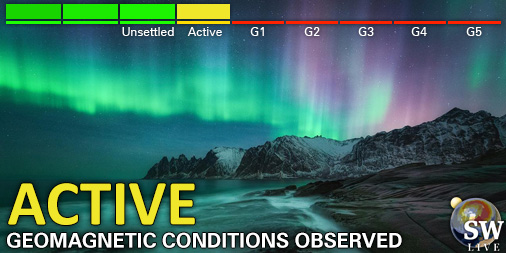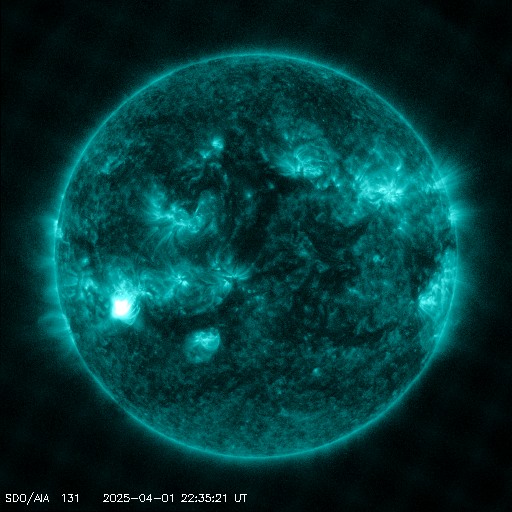Viewing archive of Friday, 2 September 2011
Solar activity report
Any mentioned solar flare in this report has a scaling factor applied by the Space Weather Prediction Center (SWPC). Because of the SWPC scaling factor, solar flares are reported as 42% smaller than for the science quality data. The scaling factor has been removed from our archived solar flare data to reflect the true physical units.
Report of Solar-Geophysical Activity 2011 Sep 02 2200 UTCPrepared by the NOAA © SWPC and processed by SpaceWeatherLive.com
Joint USAF/NOAA Report of Solar and Geophysical Activity
SDF Number 245 Issued at 2200Z on 02 Sep 2011IA. Analysis of Solar Active Regions and Activity from 01-2100Z to 02-2100Z
Solar activity was at low levels due a to C1/Sf flare
at 02/1516Z from Region 1281 (S20E01). During the period, the region
decayed slightly in area and spot count and remained a D-type,
bi-polar spot group. Region 1283 (N13E37) produced an impulsive
B8/Sf flare at 02/0852Z. The region showed penumbral development in
the trailer spots and was classified as a D-type, bi-polar spot
group. Region 1282 (N25W40) indicated an increase in area and
longitudinal extent and was classified as an E-type, bi-polar spot
group. A CME was observed lifting off the SE limb, first seen in
SOHO LASCO/C2 imagery at 02/0748Z. A plane-of-sky speed was
estimated at 375 km/s. The source of this CME appears to have
originated from a filament channel centered near S28E42. Material
motion was first observed on SDO/AIA 193 imagery at 02/0554Z. At
this time, there does not appear to be an Earthward-directed
component.
IB. Solar Activity Forecast
Solar activity is expected to be low
through the period (03 - 05 September) with a slight chance for
M-class activity.
IIA. Geophysical Activity Summary 01-2100Z to 02-2100Z
The geomagnetic field was quiet. Solar wind speeds, as measured at
the ACE spacecraft, were steady below 300 km/s through the period. A
phi angle change from negative (toward) to positive (away) was
observed at approximately 02/0900Z. The Bz component of the
interplanetary magnetic field was predominately negative through the
period at about -4 nT.
IIB. Geophysical Activity Forecast
The geomagnetic field is
expected to be at quiet to unsettled levels, with a slight chance
for active periods, on days one and two (03 - 04 September). This
increase in activity is due to a recurrent coronal hole high speed
stream expected to rotate into a geoeffective position early on 03
September. By day three (05 September), field activity is expected
to return to mostly quiet levels.
III. Event Probabilities 03 Sep to 05 Sep
| Class M | 10% | 10% | 10% |
| Class X | 01% | 01% | 01% |
| Proton | 01% | 01% | 01% |
| PCAF | Green | ||
IV. Penticton 10.7 cm Flux
Observed 02 Sep 115 Predicted 03 Sep-05 Sep 115/115/110 90 Day Mean 02 Sep 097
V. Geomagnetic A Indices
Observed Afr/Ap 01 Sep 001/003 Estimated Afr/Ap 02 Sep 003/005 Predicted Afr/Ap 03 Sep-05 Sep 008/008-008/008-005/005
VI. Geomagnetic Activity Probabilities 03 Sep to 05 Sep
| A. Middle Latitudes | |||
|---|---|---|---|
| Active | 20% | 20% | 15% |
| Minor storm | 05% | 05% | 01% |
| Major-severe storm | 01% | 01% | 01% |
| B. High Latitudes | |||
|---|---|---|---|
| Active | 25% | 25% | 20% |
| Minor storm | 10% | 10% | 05% |
| Major-severe storm | 01% | 01% | 01% |
All times in UTC
Current data suggests there is a slight possibility for aurora to appear at the following high latitude regions in the near future
Whitehorse, YTFairbanks, AK, Utqiagvik, AK
Latest news
Latest forum messages
AR4046 157Unexplained proton activity 53AR4048 101Temporary Topic - Ongoing Solar Proton Events 17jsoc 108
More topicsSupport SpaceWeatherLive.com!
A lot of people come to SpaceWeatherLive to follow the Sun's activity or if there is aurora to be seen, but with more traffic comes higher server costs. Consider a donation if you enjoy SpaceWeatherLive so we can keep the website online!

Latest alerts
Wednesday, 2 April 2025
04:03 UTC - Hemispheric Power Index
The OVATION model predicts the Hemispheric Power Index to reach 50GW at 04:56 UTC
01:45 UTC - Geomagnetic activity
Active geomagnetic conditions (Kp4) Threshold Reached: 01:32 UTC
Tuesday, 1 April 2025
22:51 UTC - Solar flare
Moderate M2.5 flare
22:30 UTC - Radio Blackout
Minor R1 radio blackout in progress (≥M1 - current: M1.45)
Space weather facts
| Last X-flare | 2025/03/28 | X1.1 |
| Last M-flare | 2025/04/01 | M2.5 |
| Last geomagnetic storm | 2025/03/27 | Kp5 (G1) |
| Spotless days | |
|---|---|
| Last spotless day | 2022/06/08 |
| Monthly mean Sunspot Number | |
|---|---|
| February 2025 | 154.6 +17.6 |
| April 2025 | 152.5 -2.1 |
| Last 30 days | 130.7 -17.9 |




